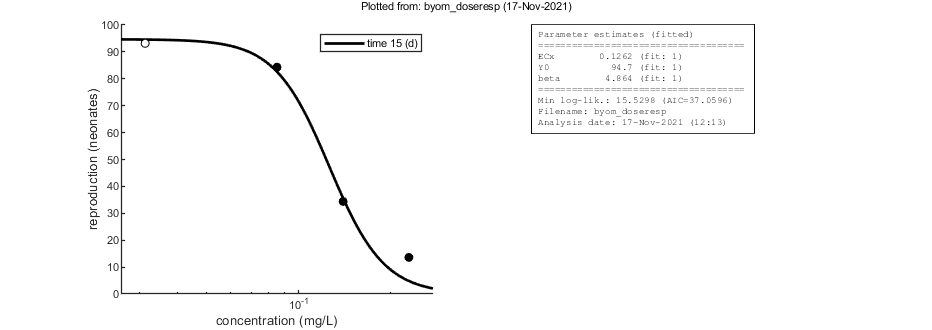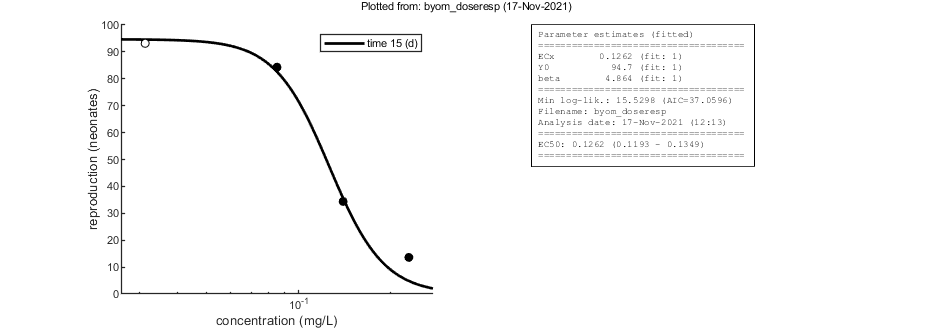BYOM, byom_doseresp.m
Table of contents
Contents
About
- Author: Tjalling Jager
- Date: November 2021
- Web support: http://www.debtox.info/byom.html
- Back to index walkthrough_doseresp.html
BYOM is a General framework for simulating model systems in terms of ordinary differential equations (ODEs) or explicit functions. This package only supports explicit functions, which are calculated by simplefun.m, which is called by call_deri.m. The files in the BYOM engine directory are needed for fitting and plotting. Results are shown on screen but also saved to a log file (results.out).
The model: Log-logistic dose response fitting.
This script: Example for reproduction data, using the likelihood function based on a normal distribution of the residuals (various transformation are optional).
Copyright (c) 2012-2021, Tjalling Jager, all rights reserved. This source code is licensed under the MIT-style license found in the LICENSE.txt file in the root directory of BYOM.
Initial things
Make sure that this script is in a directory somewhere below the BYOM folder.
clear, clear global % clear the workspace and globals global DATA W X0mat % make the data set and initial states global variables global glo % allow for global parameters in structure glo diary off % turn of the diary function (if it is accidentaly on) % set(0,'DefaultFigureWindowStyle','docked'); % collect all figure into one window with tab controls set(0,'DefaultFigureWindowStyle','normal'); % separate figure windows pathdefine(0) % set path to the BYOM/engine directory (option 1 uses parallel toolbox) glo.basenm = mfilename; % remember the filename for THIS file for the plots glo.saveplt = 0; % save all plots as (1) Matlab figures, (2) JPEG file or (3) PDF (see all_options.txt)
The data set
Data are entered in matrix form, time in rows, scenarios (exposure concentrations) in columns. First column are the exposure times, first row are the concentrations or scenario numbers. The number in the top left of the matrix indicates how to calculate the likelihood:
- -2 for binomial likelihood (dose-response fitting of survival data)
- -1 for multinomial likelihood (for survival data)
- 0 for log-transform the data, then normal likelihood
- 0.5 for square-root transform the data, then normal likelihood
- 1 for no transformation of the data, then normal likelihood
% Cumulative reproduction Daphnia after 15 days exposure to cadmium. % Exposure in mg/L. More replicates can be entered, but only enter one % exposure time! DATA{1} = [1 15 0 93.2 0.085 84.3 0.14 34.4 0.23 13.6]; % Weight factors (number of individuals per observation in data set) W{1} = [9 8 6 1]; % Derive initial values from the data set, and plotting range for model % curve. The code below calls a small function with rules-of-thumb to come % up with relevant starting values. [Y0,ECx,logc] = startvals(DATA{1},W{1});
Initial values for the state variables
Initial states, scenarios in columns, states in rows. First row are the 'names' of all scenarios.
X0mat(1,:) = DATA{1}(1,2); % assume second element of first row is the scenario (exposure duration)
X0mat(2,:) = 0; % initial values state 1 (not used)
Initial values for the model parameters
Model parameters are part of a 'structure' for easy reference.
glo.x_EC = 50; % the x in the ECx glo.logsc = 1; % plot the dose-response curve on log-scale % syntax: par.name = [startvalue fit(0/1) minval maxval]; par.ECx = [ECx 1 0 1e6]; % ECx, with x in glo.x_EC par.Y0 = [Y0 1 0 1e6]; % control response par.beta = [4 1 0 100]; % slope factor of the log-logistic curve
Time vector and labels for plots
Specify what to plot. If time vector glo.t is not specified, a default is used, based on the data set. Note that t is now used for the exposure concentrations!
if glo.logsc == 1 % when plotting on log-scale ... % glo.logzero = 0.01; % option to override automatic position for plotting the control treatment on log-scale if isfield(glo,'logzero') && log10(glo.logzero) < logc(1) % if we modify the position of the control ... logc(1) = log10(glo.logzero) - log10(1.2); % also adapt the lower part of the plotting range end glo.t = [0,logspace(logc(1),logc(2),300)]; % use a log-spacing for the model curve % Note: t=0 needs to be in there for the calculation of the model for the control treatment else % otherwise ... glo.t = linspace(0,10^(logc(2)),300); % otherwise, use a fine linear spacing for the model curve end % specify the y-axis labels for each state variable glo.ylab{1} = 'reproduction (neonates)'; % specify the x-axis label (same for all states) glo.xlab = 'concentration (mg/L)'; glo.leglab1 = 'time '; % legend label before the 'scenario' number glo.leglab2 = '(d)'; % legend label after the 'scenario' number prelim_checks % script to perform some preliminary checks and set things up % Note: prelim_checks also fills all the options (opt_...) with defauls, so % modify options after this call, if needed.
Calculations and plotting
Here, the functions are called that will do the calculation and the plotting. Profile likelihoods are used to make robust confidence intervals. Note that the dose-response curve is plotted on a log scale for the exposure concentration. If the control is truly zero, it is plotted as an open symbol, at a low concentration on the x-axis. However, for the fitting, it is truly zero.
opt_optim.fit = 1; % fit the parameters (1), or don't (0) opt_optim.it = 0; % show iterations of the optimisation (1, default) or not (0) opt_plot.annot = 1; % extra subplot in multiplot for fits: 1) box with parameter estimates, 2) overall legend % optimise and plot (fitted parameters in par_out) par_out = calc_optim(par,opt_optim); % start the optimisation calc_and_plot(par_out,opt_plot); % calculate model lines and plot them disp(['x in ECx is: ',num2str(glo.x_EC)])
Goodness-of-fit measures for each state and each data set (R-square)
Based on the individual replicates, accounting for transformations, and including t=0
state 1. 0.99
=================================================================================
Results of the parameter estimation with BYOM version 6.0 BETA 6
=================================================================================
Filename : byom_doseresp
Analysis date : 17-Nov-2021 (12:13)
Data entered :
data state 1: 4x1, continuous data, no transf.
Search method: Nelder-Mead simplex direct search, 2 rounds.
The optimisation routine has converged to a solution
Total 116 simplex iterations used to optimise.
Minus log-likelihood has reached the value 15.53 (AIC=37.06).
=================================================================================
ECx 0.1262 (fit: 1, initial: 0.1091)
Y0 94.70 (fit: 1, initial: 93.2)
beta 4.864 (fit: 1, initial: 4)
=================================================================================
Time required: 0.1 secs
Plots result from the optimised parameter values.
Due to your small screen size, all multiplots 2x2 and larger will be scaled down.
x in ECx is: 50

Profiling the likelihood
By profiling you make robust confidence intervals for one or more of your parameters. Use the names of the parameters as they occurs in your parameter structure par above. This can be a single string (e.g., 'ECx'), a cell array of strings (e.g., {'ECx','beta'}), or 'all' to profile all fitted parameters. This example produces a profile for ECx and provides the 95% confidence interval (on screen and indicated by the horizontal broken line in the plot).
Options for profiling can be set using opt_prof (see prelim_checks.m).
[par_better,Xing] = calc_proflik(par_out,'ECx',opt_prof,opt_optim); % calculate a profile % Note that the confidence intervals our now returned in _Xing_ (as % crossings of the chi-square criterion), which contains the CIs for all % profiled parameters as a cell array. Below, the CI for ECx (in _Xing{1}_) % is added to the annotation box for subsequent plotting. glo.str_extra{1} = sprintf('EC%1.0f: %6.4g (%4.4g - %4.4g)',glo.x_EC, par_out.ECx(1),Xing{1}([1 end],1)); calc_and_plot(par_out,opt_plot); % calculate model lines and plot them

95% confidence interval(s) from the profile(s) ================================================================================= ECx interval: 0.1193 - 0.1349 ================================================================================= Time required: 3.7 secs Plots result from the optimised parameter values. Due to your small screen size, all multiplots 2x2 and larger will be scaled down.

Likelihood region
Another way to make intervals on model predictions is to use a sample of parameter sets taken from the joint likelihood-based conf. region. This is done by the function calc_likregion.m. It first does profiling of all fitted parameters to find the edges of the region. Then, Latin-Hypercube sampling, keeping only those parameter combinations that are not rejected at the 95% level in a lik.-rat. test. The inner rim will be used for CIs on forward predictions.
Options for the likelihood region can be set using opt_likreg (see prelim_checks.m). For the profiling part, use the options in opt_prof.
Note: in this example, the likelihood-region sampling takes a bit of time, which is related to the 'plateau' in the likelihood for parameter beta (apparently, large values of beta are not that bad; though they are outside of the 95% CI).
% % UNCOMMENT LINE(S) TO CALCULATE % opt_likreg.detail = 2; % detailed (1) or a coarse (2) calculation % opt_likreg.subopt = 0; % number of sub-optimisations to perform to increase robustness % opt_likreg.burst = 10000; % number of random samples from parameter space taken every iteration % calc_likregion(par_out,500,opt_likreg,opt_prof,opt_optim); % % Second entry is the number of accepted parameter sets to aim for. Use -1 % % here to use a saved set.
Plot results with confidence intervals
The following code can be used to make a standard plot (the same as for the fits), but with confidence intervals. Options for confidence bounds on model curves can be set using opt_conf (see prelim_checks).
Use opt_conf.type to tell calc_conf which sample to use: -1) Skips CIs (zero does the same, and an empty opt_conf as well). 1) Bayesian MCMC sample (default); CI on predictions are 95% ranges on the model curves from the sample 2) parameter sets from a joint likelihood region using the shooting method (limited sets can be used), which will yield (asymptotically) 95% CIs on predictions 3) as option 2, but using the parameter-space explorer
% % UNCOMMENT LINE(S) TO CALCULATE % opt_conf.type = 2; % use the values from the slice sampler (1) or likelihood region (2) to make intervals % opt_conf.lim_set = 2; % use limited set of n_lim points (1) or outer hull (2, likelihood methods only) to create CIs % % out_conf = calc_conf(par_out,opt_conf); % calculate confidence intervals on model curves % calc_and_plot(par_out,opt_plot,out_conf); % call the plotting routine again to plot fits with CIs